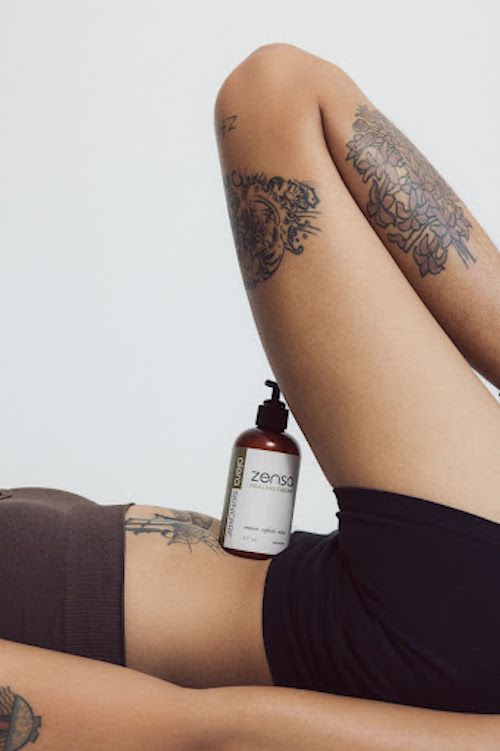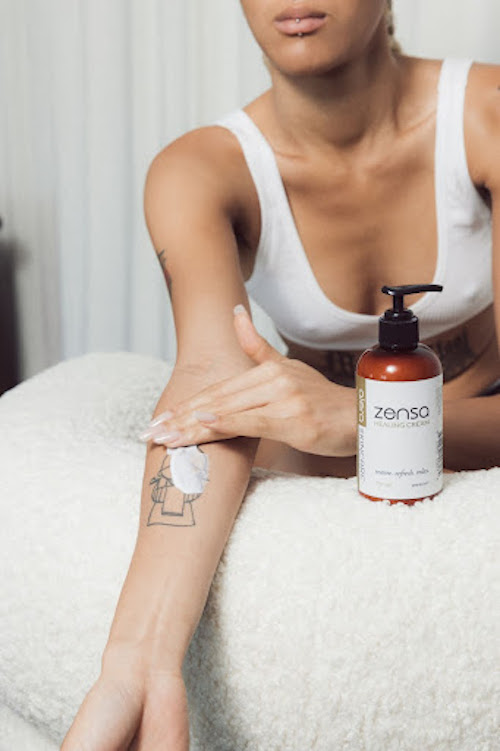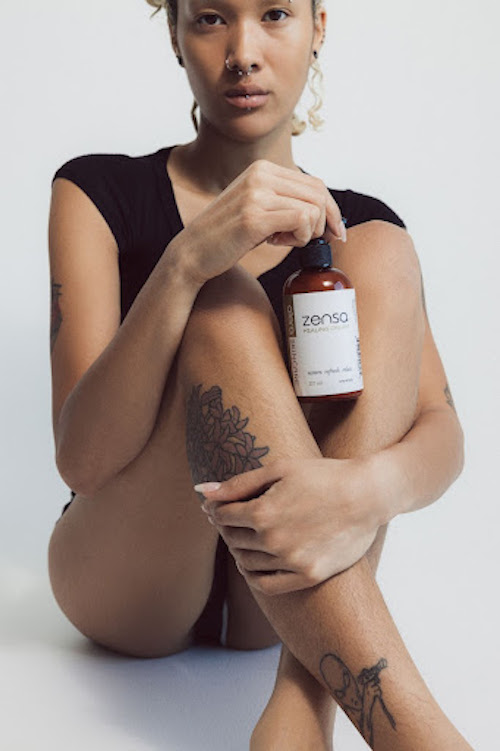Humectant vs. Emollient vs. Occlusive: Differences Among Types of Skin Moisturizers, Explained
Humectant vs. Emollient vs. Occlusive: Differences Among Types of Skin Moisturizers, Explained
Hydration is essential for healthy skin. One of the key indicators of healthy skin is a strong, well-functioning skin barrier. Repairing and maintaining a healthy skin barrier requires ample hydration and moisture from a variety of topically-beneficial nutrients. A balanced skincare routine will look different for everyone – depending on your skin type, concerns and complexion-specific needs, which take your lifestyle, environmental factors (climate, urbanity, etc.) dietary choices and genetics into consideration. Think of humectants, emollients and occlusives as the protein, carbs and fats of your skin barrier hydration regimen. Each of these moisturizing agents serves a specific function to keep your skin barrier happy, healthy and well-nourished. Some skincare ingredients contain a dominant moisturizer type or contain a mixture of these two or three agents in different ratios (akin to how beans are a rich source of protein and carbs or sunflower seeds are rich in healthy fat sources and high in protein), which can inform how you combine them with other skincare ingredients to meet your complexion’s unique needs (aka create a “balanced plate” for optimal skin hydration).
Expert Tip: Zensa Healing Cream contains humectant, emollient and occlusive ingredients, including medicinal-grade calendula oil, sunflower seed oil, avocado oil, shea butter, aloe vera, hyaluronic acid and glycerin to hydrate, soften and seal in moisture to repair the skin barrier. Our vegan, cruelty-free formula is designed to hydrate dry, itchy skin, reduce inflammation, irritation or redness, minimize hyperpigmentation (including scarring), soothe eczema symptoms and accelerate the wound healing process after getting a tattoo, PMU or cosmetic treatment done. Use Zensa Healing Cream twice daily for best results.
Read on for a full guide on the differences between humectants vs. emollients vs. occlusives (with ingredient examples), how they benefit different skin types and how these three types of skin moisturizers maintain or help repair a damaged skin barrier.
What is The Skin Barrier?
While each of these moisturizing ingredients has unique qualities, they all serve a universal purpose: to protect the skin barrier and reverse any signs of potential damage. The skin barrier relies on absorbing and locking in moisture to act as an external filtration system for the body. When functioning properly, your skin barrier shields your complexion from inflammation, infections, pollutants and other environmental toxins (such as sun damage). A damaged skin barrier is often caused by inadequate moisture that strips the lipid barrier necessary to bind your skin cells together. Signs of a damaged skin barrier can include all types of skin issues, from acne, fine lines or wrinkles and dehydrated, dry, itchy skin to inflammatory conditions like eczema, psoriasis, rosacea, skin rashes, scarring and hyperpigmentation.
Humectants vs. Emollients vs. Occlusives: Decoding Different Types of Moisturizers
What is A Humectant?
Humectants are the ultimate skin hydrator. These substances act like a sponge to draw water into the skin barrier. They can absorb up to between 100-1,000% times their weight to nourish and hydrate the skin. Humectants also help exfoliate dead skin cells, soothe irritation and plump the skin to reduce the appearance of fine lines and wrinkles. Individuals with all skin types can benefit from using humectants. The type of humectant you use depends on how much moisture your unique complexion needs. Humectants also help dissolve actives and preserve products.
Side Effects of Humectants: While side effects with humectants are rare (and mild), it is possible for a humectant product to provide results opposite to its intended effect. If you’re in a low-humidity environment, applying a humectant multiple times daily pulls moisture from the deeper layers of the skin and can significantly dry out your complexion. Always dampen the skin before applying a humectant. Help your skin retain this moisture by using a humectant with occlusive properties (or a compatible product).
How to Use Humectants: A humectant can be used by an individual with any skin type, both in the morning or night and through every season. Pair humectant products with occlusives to lock in moisture when building your skincare routine (unless you live in an extremely-high humidity environment). Apply your humectant(s) of choice 1-2 times daily.
Humectants for Skin (Examples & Ingredients):
-
Cucumber Extract
-
Glycerin (Glycerol)
-
AHAs: Lactic Acid; Mandelic Acid
-
Sorbitol
-
Honey
-
Urea
-
Sodium PCA
-
Aquaxyl
-
Zemea

What is An Emollient?
Emollients are moisturizing substances that fill the gaps between skin cells with lipids to repair and strengthen the moisture barrier. When depleted of water, the top layer of skin dries out and weakens skin barrier functioning. Emollient helps soften and soothe the skin to relieve the signs of a compromised skin barrier, including cracked skin, flaky or rough patches, inflammation or generally dry, itchy skin. These substances are particularly helpful for individuals who live in colder climates or other dry air environments (e.g. using a heater during the winter), wash their hands or take hot showers frequently and those managing eczema, psoriasis or flare-ups from similar chronic skin conditions. There are three popular types of emollients: lotions, creams and ointments (listed in order from lowest to highest oil-to-water ratio).
Side Effects of Emollients: Rare side effects of using emollients include skin burning, redness, dryness, stinging or inflamed hair follicles (folliculitis) that can cause small boils. If you have oily skin, emollients can clog your pores and cause or lead to more severe acne breakouts (especially if you’re using emollients with higher oil concentrations).
Emollients for Skin (Examples & Ingredients):
-
Avocado Oil
-
Almond Oil
-
Ceramides
-
Coconut Oil
-
Colloidal Oatmeal
-
Jojoba Oil
-
Mineral Oil
-
Paraffin
-
Shea Butter
-
Squalane

What is An Occlusive Moisturizer?
Occlusives are moisturizers that, essentially, mimic the natural lipid barrier. They create a protective layer on the skin’s surface and fill gaps in an otherwise damaged skin barrier to prevent moisture loss (aka transepidermal water loss). Occlusives are oil-rich and have a thick consistency with low water content. An occlusive moisturizer acts like a shield to protect the skin from outside pollutants, such as cold wind, bacteria, pollen, friction and other irritants. It is typically recommended to always use an occlusive moisturizer during the winter or when you’re in an environment with cold, dry air. Even if you don’t step outdoors often during this chilly season, remember that indoor heaters or steaming hot showers can also strip the moisture barrier.
Adding an occlusive to your skincare routine whenever the humidity is low allows your skin to prevent (further) skin barrier damage when there is no moisture to draw from in the air. Occlusives are ideal for individuals with dry, dehydrated skin and those suffering from eczema, atopic dermatitis, psoriasis or similar inflammatory conditions. However, an occlusive moisturizer might be the best choice for many individuals with oily or acne-prone skin.
Side Effects of Occlusive Moisturizers: Occlusives can be too oily for some skin types and clog pores, cause breakouts or leave your skin with an undesirable greasy sheen. Applying an occlusive moisturizer in thick layers or too frequently can leave you with results opposite to the ingredient’s intended effect. Some side effects of overusing occlusives include bumps on the skin, increased acne or inflammation.
How to Use Occlusive Moisturizers: Occlusive moisturizers should always be the last step in your skincare routine (with the exception of sunscreen in the morning). Consider occlusives to be like a barrier method of protection for skin hydration. They lock in all of the nutrients from your other skincare ingredients and seal in moisture from any humectant or emollient ingredients used previously. However, because no previously-applied ingredients can permeate an occlusive, sunscreen must be applied afterward to ensure your skin can utilize its SPF protection.
Occlusives for Skin (Examples & Ingredients):
-
Argan Oil
-
Avocado Oil
-
Beeswax
-
Calendula Oil
-
Cocoa Butter
-
Jojoba Oil
-
Lanolin
-
Mineral Oil
-
Petroleum Jelly
-
Paraffin
-
Shea butter
-
Squalane

Humectant vs. Emollient
Consider humectants and emollients as the supporters vs. the sponsors of a healthy skin barrier.
Humectants are oil-free hydrators. They draw water into the skin to replenish skin moisture and work to smooth and plump fine lines or wrinkles. These water-based ingredients restore skin hydration without a greasy film that could clog pores or cause breakouts. Humectants work well for all skin types and are great for individuals with oily, combination or acne-prone skin. They also are ideal to use on your skin in the summer or in areas with high humidity.
Emollients refer to three types (lotions, creams and ointments) of moisturizers with varying water-to-oil ratios that work to restore the lipid barrier, soothe and soften the skin. Lotions, aka water-based emollients, have a thinner consistency and less oil than creams or ointments, so they absorb faster and feel more lightweight on the skin. Water-based emollients are great for normal or oily skin types. Creams are the Goldilocks of emollients: They contain equal parts water and oil to lock in deep moisture and calm redness, irritation or inflammation (like eczema flare-ups) without causing oil buildup or a greasy residue.
Zensa Healing Cream contains a balance of humectant and occlusive ingredients that have emollient properties (i.e. aloe vera is a humectant with emollient properties, and shea butter is an occlusive with emollient properties) to offer several skin hydration benefits. They are combined with antibacterial, medicinal-grade calendula oil and grapefruit oil to keep these moisturizing ingredients in check and minimize breakouts or infections for those with acne-prone or oily skin.
Ointments are the lovechild of occlusives and emollients. These oil-based emollients, often called occlusive emollients, have a thick and greasy texture that contains more oil than water. They soften the skin and replenish the lipid barrier, while also forming a protective barrier to seal and lock in moisture. Like occlusives, ointments should only be used on extremely dry or cracked skin.

Emollient vs. Occlusive
Emollients and occlusives are like the child and the parent of the skin moisturizer family. Occlusives are essentially waterless emollients that are thicker, heavier and completely oil-based. Emollients fill in the gaps in the lipid barrier. While they offer varying degrees of concentrated moisture, most emollients (lotions and creams) will absorb into the skin and can be adaptable regarding how they interact with your complexion. Occlusives, on the other hand, are more set in their ways: They create an oil-based film that essentially acts like a temporary second skin barrier. This occlusive shield seals in moisture and prevents transepidermal water loss while keeping irritants and pollutants out and protecting the skin barrier from the influence of these potentially-damaging external sources.
Because they are more lightweight and permeable, emollients are recommended for all skin types – from normal to very dry skin. Some individuals with very oily skin might feel greasy or break out from using emollients. Lotions typically work well for individuals with oily skin. Look for oil-free moisturizers if you have skin concerns like excess sebum production or are prone to acne breakouts.
Occlusives and occlusive emollients (ointments) are recommended only for individuals with dry to extremely dry skin or for use during the colder months. These rich oil-based formulas can soothe cracked, inflamed or dry, itchy skin. However, they can easily clog pores or overwhelm skin types with more balanced or high oil production levels.
Humectant vs. Occlusive
Humectants and occlusives are the water and oil within the skin moisturizer trifecta. They hydrate the skin in polar opposite ways. Humectants water super-attractors: They draw moisture into the skin from their environment, other skincare products or even the deeper layers of skin as a last resort (the latter method is undesirable). Occlusives are water-repellent and are gatekeepers of the skin barrier. Sitting on the surface of the skin, occlusives hydrate the skin by preserving all existing hydration and sealing in this moisture to prevent water from escaping via transepidermal water loss.
However, unlike water and oil, humectant and occlusive ingredients often work best when layered together. Always make sure to use a humectant on damp skin and complete your routine with the occlusive agent. Here’s more information on how to build your skincare routine and use products in the correct order.
For most individuals, looking for a skin moisturizer that offers a triple threat – of humectants, emollients and occlusives – is ideal for a healthy skin barrier. Zensa Healing Cream contains humectants (aloe vera, cucumber extract, hyaluronic acid and glycerin) and nourishing ingredients with emollient and occlusive properties (calendula oil, avocado oil and shea butter) to reduce inflammation, nourish dry, itchy skin, soothe eczema symptoms, accelerate wound-healing and minimize acne scarring or other forms of hyperpigmentation to ultimate repair and maintain a healthy, hydrated skin barrier.
